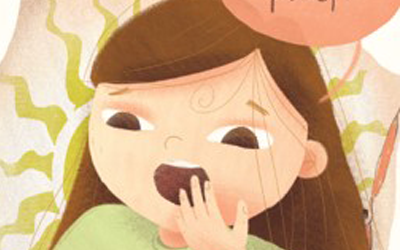Fear and anxiety are different concepts. Fear occurs when the threat is certain or visible, and close in terms of time and place. It is characterized by physical arousal and a disproportionately negative emotional response to the “threat”.
At the behavioral level, it is characterized by survival reactions of escape. For example, a child who is afraid of dogs and sees a dog in front of him, will stay away from the place where the dog is or even return to his home.
Anxiety is characterized by tension, apprehension, worry and general distress about a negative event that may occur in the future, even without the presence of immediate danger. Excessive worry is the typical example of anxiety. For example, a child who constantly worries that his father or mother will get seriously ill.
It seems that it is easier for parents to notice the symptoms of fear than anxiety. That is, it is easier for parents to see when their children are scared, but symptoms of anxiety, such as worries and physical sensations can remain hidden, especially if the child does not report them.
Anxiety disorders can be divided into several types in general, although many times children will suffer from several disorders at the same time, including disorders that are not in the field of anxiety (eg attention deficit disorder, depression).
Types of anxiety disorders
Separation Anxiety in children – In this anxiety disorder, most of the child’s anxiety and fears are focused on an expected or current separation from their parents/main caregiver. Children with Separation Anxiety are often “sticky” to their parents, have great difficulty sleeping alone, sometimes resist going to school and can also exhibit physical complaints during or before separation from their parents.
Generalized Anxiety disorder in children – These children have many and uncontrollable worries about diverse issues, for example concerns and worries related to achievements, grades, punctuality, appearance, impression and concerns that they or a family member will be hurt. These children complain, among other things, of headaches, stomachaches, stress, difficulty sleeping and difficulty concentrating.
Social Anxiety Disorder in children (Social phobia) – Children suffering from Social Anxiety are usually described as shy and in some cases will even refuse to talk to people they don’t know, especially adults. They will show anxiety in a wide variety of social situations where they will feel uncomfortable and think that they are being negatively evaluated by others. Many times they will think that they might do something embarrassing or “stupid” and that they will be laughed at. These children avoid situations where these fears emerge (eg school, group meetings, speaking in front of the class, etc.). These children may complain of physical sensations while being exposed at a social event or before entering a social event (for example, on a day when they have to read something in front of the class).
Panic disorder and Agoraphobia in children – This disorder is characterized by unexpected anxiety/panic attacks. This disorder usually develops after puberty. Panic attacks are usually characterized by a sudden onset of physical sensations including increased heart rate, sweating, tremors, difficulty and rapid breathing and other symptoms. In this situation thoughts of death, fainting and loss of control arise.
Panic attacks are accompanied by frequent visits to the pediatrician, emergency room, and specialist doctors (cardiologists, neurologists, etc.). Children suffering from panic disorder will avoid or be in great distress in situations where they fear that these symptoms will appear (for example, crowded places, driving, etc.)
Obsessive Compulsive Disorder (OCD) in children – OCD is characterized by obsessions (repeated and disturbing thoughts/images that cause anxiety) and/or compulsions (repeated behaviors in an attempt to deal with the disturbing and anxiety-provoking thoughts). Common obsessions include thoughts of contamination, doubt, thoughts involving themes related to sex or religion, symmetry, order, and aggressive thoughts.
In an attempt to deal with these thoughts, the child will commit compulsions trying to lower the tension and anxiety. Common compulsions include repeated hand washing, checking, tidying and counting.
Specific Phobia – Refers to a certain stimulus/situation/object that creates or causes a strong fear reaction. Common specific phobias in children are related to animals, darkness, heights, lightning and thunder.
Why does anxiety persist?
There are several reasons for the emergence of anxiety disorders and for the fact that they persist .
Heredity – Anxiety disorders tend to be hereditary, with the hereditary component in most anxiety disorders being about 50%.
Biology – A part of the brain called the “amygdala” which regulates our responses to anxiety-provoking stimuli (for example response to scary facial expressions) tends to react more to stimuli in children and adults with anxiety disorders.
Negative or traumatic experiences of the child – Such as neglect (also of mental needs), traumatic experiences, abuse and events of separation (such as separation from a parent).
Learning, environment – A child who grows up in a home with a father or mother suffering from an anxiety disorder, may be exposed to the anxious form of coping and it is possible that they too will adopt this way. For example, a parent who does not drive or avoids taking the elevator.
Thinking style – Includes overestimation of danger, alertness, catastrophic thinking.
The child’s coping methods – Usually avoidance.
The behavior of the parents (what is the parenting style) – Protective or demanding parental styles
For our picture book that helps parents and children cope with fears and anxiety in children click here




0 Comments